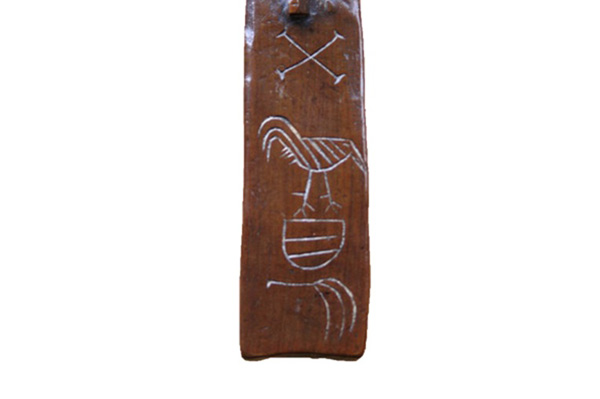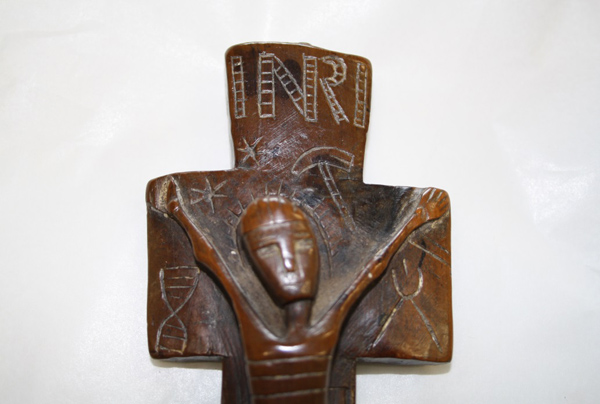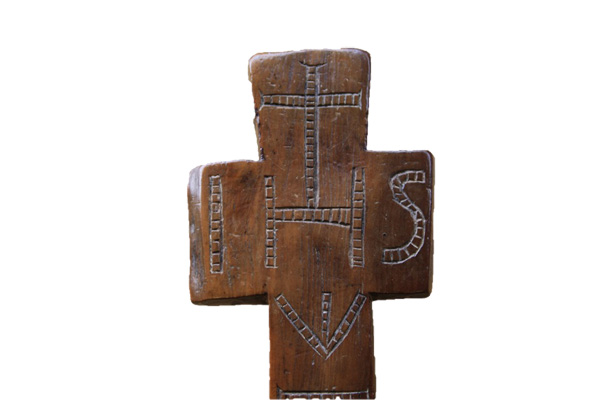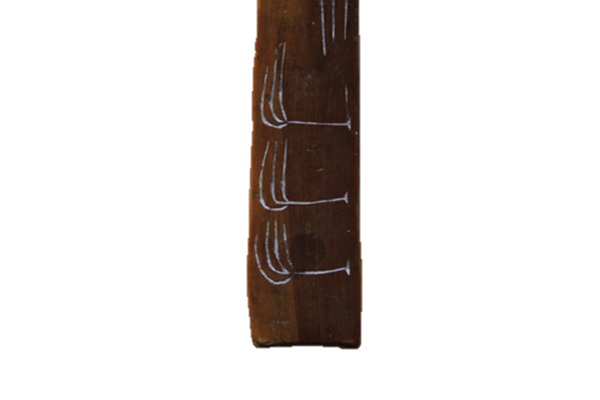1721
Penal Cross from County Galway
Penal cross featured in Joseph Bigger’s 1909 publication Irish Penal Crosses 1713-1781.
By Joanne HamiltonDescription
The cross is 28cm long and 6.5cm across the arms. The figure of Christ is in relief and from head to foot is 14cm long. Head is oval, crown of thorns shown by vertical lines, the arms are stretched upwards, the hands reaching to the upper corners of the cross arms. The torso is rectangular, ribs being indicated by 3 horizontal lines. Feet crossed and fastened together by a nail. Below the feet are the remains of an object which may have represented a skull. Across the top of the shaft is INRI in letters 1.5cm high and formed in ladder technique. The head is surrounded by a rayed nimbus and to the right above it are two stars and to the left a hammer. Below the feet are two lines in X formation, representing crossed bones. At the bottom of the shaft is a cock rising from a pot and a scourge with three lashes.
On the reverse IHS is incised across the transom rising from the crossbar of the H and filling upper shaft. Below this the three nails with converging points. The date on shaft reads 1721. Following this are four three lashed scourges.
What were Penal Crosses?
Penal crosses represented devotional artefacts. Their name derives from the fact that they were somewhat contemporaneous with the Penal Laws. The Penal Laws created a wave of economic, social and religious hardship across Ireland. The penal cross signified a tangible, portable relic of worship for Catholics whose religion was under great threat. In his study, A.T. Lucas suggests a range of dates from the eighteenth to early nineteenth century for penal crosses.
It is thought that they have a strong association with the pilgrimage site at Lough Derg, County Donegal where they were made and sold to pilgrims visiting the site and subsequently kept as relics.
Lucas states that:
“The manufacture of crucifixes of an undoubted “penal” type in the locality for sale to the pilgrims of the mid-nineteenth, suggests the possibility that the whole genus of these objects may be associated with the Lough Derg pilgrimage” (Lucas, 1954, p. 168).
Penal crosses were made of a single piece of wood and of simple cruciform shape with short arms and a figure of Christ carved in high relief at the centre. They range in size from reasonably large (such as this example) to very small.
Symbolism and meaning on Irish penal crosses
Various inscriptions and symbols representing the Passion of Christ were carved around the central figure. The most commonly occurring inscriptions were:
INRI Iesus Nazarenus Rex Iudaeorum/ Jesus the Nazarene, the King of the Jew
IHS Iesus Huios Sother/ Jesus, Son, Saviour
Commonly inscribed symbols were:
A Hammer Which nailed Christ to the cross
A Spear Which pierced Christ’s side on the cross
Scourge(s) Used to lash Christ
A Ladder Used to take down the body of Jesus
Cock and Pot This symbol has its roots in the story of Judas from the Gospel of Nicodemus. Following his betrayal of Christ, Judas returns to his home with the intention of killing himself. His wife is roasting a cock over the fire. She tells a distressed Judas that Jesus is as likely to rise from the dead as the cock she is cooking is likely to come to life. With that the cock flew out of the pot and crowed.
The back of the crosses are more sparsely decorated often with a date inscribed. The letters IHS also occur on the reverse frequently with a cross rising from the bar of the H.




Where did this cross come from?
This cross comes from County Galway where it is was in the possession of the Brown family of Cooloo. It was presented to the National Museum by Dr. Thomas Costello of Tuam, Co. Galway in 1932.
Where can Penal Crosses be seen?
The National Museum of Ireland - Country Life, Turlough Park, Castlebar, Co. Mayo has over 70 Penal Crosses in its collection. This cross F:1932.95 is part of the reserve collection and is not currently on display.
Learn more
Bigger, J. (1909) Irish Penal Crosses 1713-1781, Belfast
Lucas, A.T. (1954) ‘“Penal” Crucifixes’ Journal of Louth Archaeological Society Vol. XIII (No. 2), 145-174
Nugent, L. (2013) ‘Penal Crosses found in Co. Carlow: the significance of 18th and 19th century devotional crucifixes in early modern Ireland’ Carloviana Vol. 65, 84-88
Location:
Penal Cross from County Galway is located at:
In Storage
Previous artefact:
Next artefact:
